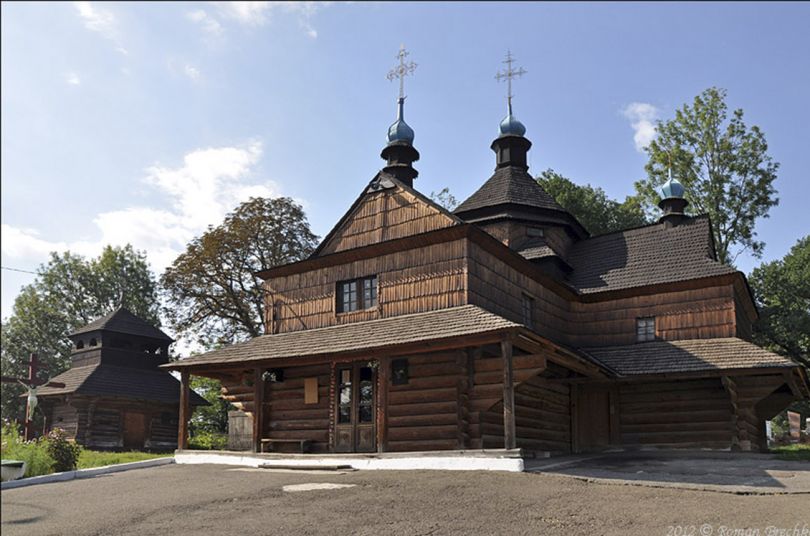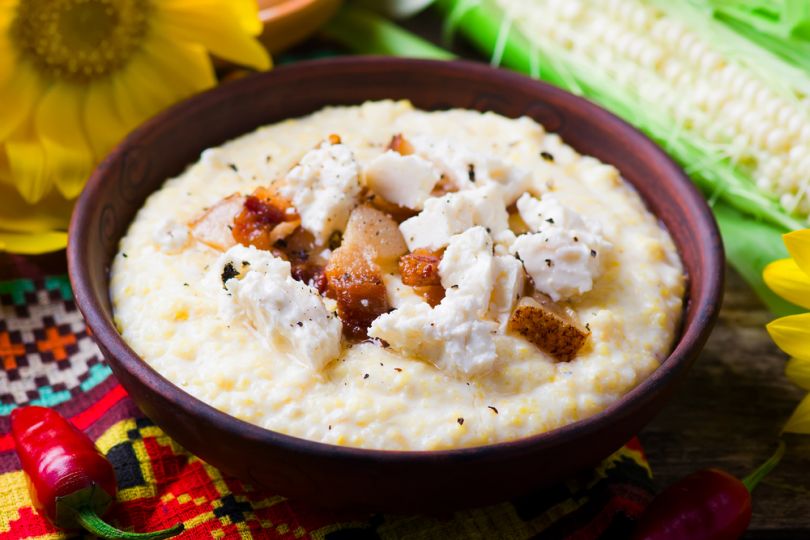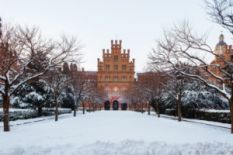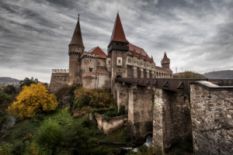History
Kolomyia, also known as Kolomea, is a small city located on the Prut River in the Ivano-Frankivsk region. While Kolomyia is tiny compared to large cities (approximately 61 thousand people), it is considered an important cultural and economic center of Pokuttia region. The first written mentioning of Kolomyia appears in the Galician–Volhynian Chronicle and is dated 1240. The city was known as a salt mining center of the region since the mid-13th century.Unfortunately, it was largely ruined during the Turkish-Tatar invasion of the 16-17th centuries, so many cultural and architectural places of interest were lost and had to be restored later. In the 18th century, Kolomyia became a part of Habsburg Empire. After the 1848 revolution in Austria, the Spring of Peoples reached the region as well: the first theater and the first Ukrainian reading room in Galicia, the first gymnasium and printing, as well as the launching of the first city newspaper were the direct influence of the revolutionary events.
The Austrian period in Kolomyia is also reflected in architecture: numerous buildings in the downtown are dated late 19th-early 20th centuries and are prime examples of Austrian architectural traditions of the era. The main pedestrian street of the city, Chornovola Street, is the best location to witness this architecture. Another prominent spot is Kolomyia Town Hall erected in 1877 after the old building burned down in a great fire. The Town Hall showcases the Renaissance Revival style. Nowadays, Kolomyia is especially famous for the Pysanka Museum, listed in the Guinness World Records, as well as the nightly Vyshyvanka Market.
The Pysanka Museum
The Pysanka Museum is, without doubts, the most famous of all attractions in Kolomyia. The reason behind is bright exterior - a large, 13.5-meter pysanka installed at the entrance of the museum attracts visitors from all over the world. Moreover, the statue is listed in Guinness World Records as the largest pysanka in the world.To give a bit of cultural background, pysanka is a decorated egg. The name derives from the Ukrainian verb “pysaty”, meaning “to draw”. Ukrainians create «pysanky» on the eggshells, and in the ancient times, these items were given as presents to friends and family on Easter Sunday. Each region in Ukraine has their tradition of decorating pysanky, where geometrical patterns and motifs can be used as a way to 'code' a message.
The Pysanka Museum in Kolomyia has more than 10 thousand pysankas from all regions of Ukraine, as well as Poland, Romania, Bilorus, diasporas in Canada, the US, France, and even Egypt and India. The museum is located in the downtown on 43B, Chornovola Avenue. The entrance ticket it UAH 25 for adults, UAH 15 for college students and UAH 10 for school students.
St. Josaphat Church (former the Cathedral of the Assumption of Mary)
 One of the oldest churches in Kolomyia, the Cathedral of the Assumption of Mary, dates back to the mid-14th century. According to historian Ryszard Brykowski, in 1353 the Cathedral of the Assumption of Mary functioned as a wooden church. However, it was ruined during the invasions of 16-17th centuries.
One of the oldest churches in Kolomyia, the Cathedral of the Assumption of Mary, dates back to the mid-14th century. According to historian Ryszard Brykowski, in 1353 the Cathedral of the Assumption of Mary functioned as a wooden church. However, it was ruined during the invasions of 16-17th centuries.
The modern Roman-Catholic church was built on the same spot during 1762‒1772. The church was a project of the famous architect Bernard Meretyn, who has worked in Western Ukraine and is renowned for planning St. George's Cathedral in Lviv. During the Soviet era, the Cathedral was dilapidated and was used first as a gym and then as a department store. In 1991, the Baroque Cathedral was redeemed; and nowadays it functions as a Greek Catholic church of St. Josaphat.
The Church of the Annunciation of the Blessed Virgin Mary
 The wooden church of the Annunciation of the Blessed Virgin Mary belongs to the must-visit places to see in Kolomyia. The church is a prime example of Hutsul sacred architecture and is located in the ancient cemetery near the 18th-century bell tower. While the exact date of construction is disputed, one of the doors in the church bears an inscription that says 1709, indicating the possible year of the church's construction.
The wooden church of the Annunciation of the Blessed Virgin Mary belongs to the must-visit places to see in Kolomyia. The church is a prime example of Hutsul sacred architecture and is located in the ancient cemetery near the 18th-century bell tower. While the exact date of construction is disputed, one of the doors in the church bears an inscription that says 1709, indicating the possible year of the church's construction.
The church was constructed according to the classical Hutsul traditions of sacred architecture - the building was divided into three sections, namely babynets, nave, and altar. The nave was built as a square. The Church of the Annunciation of the Blessed Virgin Mary was reconstructed in 1845 and gained one of its most prominent features - a gilded quadrilateral Rococo iconostasis. One of the icons depicts the Last Supper and is dated 1800.
The National Museum of Hutsulshchyna and Pokuttia Folk Art
The national museum of folk art is, in fact, art itself - it is located in downtown Kolomyia in an Austrian-style building on the corner of Shevchenko and Teatralna street. The building was erected in 1901 and served as the People's House before the museum was opened there in 1926.The museum's collection showcases more than 50 thousand artifacts that illustrate art traditions of Hutsul and Pokuttia regions. The artifacts grasp the period from the 17th century until the contemporary era. Here you will find folk art like art processing of wood, metal and leather, pottery, decorative weaving, carpet weaving, embroidery and clothing. The museum is located on 25, Teatralna Street. The admission is UAH 40 for adults, UAH 20 for college students and UAH 15 for school students.
Kolomyia Vyshyvanka Market
 As for the things to do in Kolomyia, visiting the local vyshyvanka market is often included in the tourist guides. Kolomyia market is truly unique in its working hours - it starts working on Wednesday nights, around 2 A.M. Every week masters of embroidery gather in Kolomyia to sell traditional Ukrainian shirts vyshyvanka, embroidered skirts and towels.
As for the things to do in Kolomyia, visiting the local vyshyvanka market is often included in the tourist guides. Kolomyia market is truly unique in its working hours - it starts working on Wednesday nights, around 2 A.M. Every week masters of embroidery gather in Kolomyia to sell traditional Ukrainian shirts vyshyvanka, embroidered skirts and towels.
Many of the items showcased here are handmade. Besides, guests will have a chance to buy authentic Hutsul accessories like gerdan, a wide necklace made from colorful beads. The market is located on Vasyl Atamaniuk Street. In Google Maps, it is listed as Nichnyy Rynok "Kolos".
Local cuisine
 Hutsul culture in Kolomyia is strong not only in art but also in cuisine. The local culinary traditions are somewhat similar to the Carpathian dishes. For instance, maize porridge banosh served with brynza cheese is incredibly popular in Kolomyia.
Hutsul culture in Kolomyia is strong not only in art but also in cuisine. The local culinary traditions are somewhat similar to the Carpathian dishes. For instance, maize porridge banosh served with brynza cheese is incredibly popular in Kolomyia.
One of the most popular spots to try the authentic local cuisine is sadyba 'U Vuyka Vasylya', located in Sheparivtsi village, a 10-minute drive from Kolomyia. The restaurant is located in the forest and built as a typical Hutsul house with a small tower. The interior is authentic as well. As for the menu, guests will have a chance to try salted herring, fried trout, banosh with cheese and other local specialties.
Another prominent feature of culinary culture in Kolomyia is connected to its Austrian past. Just like Lviv, Kolomyia has a strong coffee and dessert culture. Delicious steaming coffee and cakes are praised in Impreza cafe located near the Pysanka Museum. The menu here lures in visitors with a wide range of cakes, such as a classic Austrian strudel or Opera Cake.
How to travel to Kolomyia
The easiest way to travel to Kolomyia is by train - there are several daily trains that depart from different cities in Ukraine and stop at the local station:
- #357 Kyiv - Rakhiv (daily)
- #702 Lviv - Chernivtsi (all week except for Wednesday)
- #136 Odesa - Chernivtsi (daily)
- #668 Chernivtsi - Kovel (daily)
You may also travel to Kolomyia from the closest city, Ivano-Frankivsk, which is 65 kilometers away. The are several suburban expresses that go to Kolomyia. The ride takes about 1 hour. The schedule is available at the official Ukrainian Railways website. You can also use services like rome2rio.com to see which means of travel would be the cheapest.
Where to stay in Kolomyia
In the last years, more hotels and hostels have appeared in Kolomyia. As the city is still pretty small, the interior and service still leave much to be desired. However, some venues have a good rating on Booking.com.
Pysanka Hotel is located in the city center on 41, Chornovola Street. The venue has an 8.4 rating on Booking. The hotel has free Wi-Fi, parking and serves continental breakfast for a separate fee. The accommodation types include standard double and triple rooms, quadruple room, suite with a balcony and a junior suite. The price for two nights is UAH 900 for 2 adults.
Another popular venue is Friendly House, rated 9.4. It is located on 12, Pawlyka street in the city center. The wooden house can comfortably accommodate 4 people. It has a fully-equipped kitchen, bathroom with a shower, toilet and balcony. There's a gazebo for barbecue outside. Wi-Fi and parking are free. The host can also arrange airport shuttle for an additional fee.
Sources: karpaty.info, ukrmandry.com.ua.
Photo sources: uk.wikipedia.org, karpaty.love, depositphotos.com, religion.in.ua, youtube.com, karpaty.rocks, karpaty.life, artkolo.org, museum.if.ua, booking.com. All images belong to their rightful authors.





















